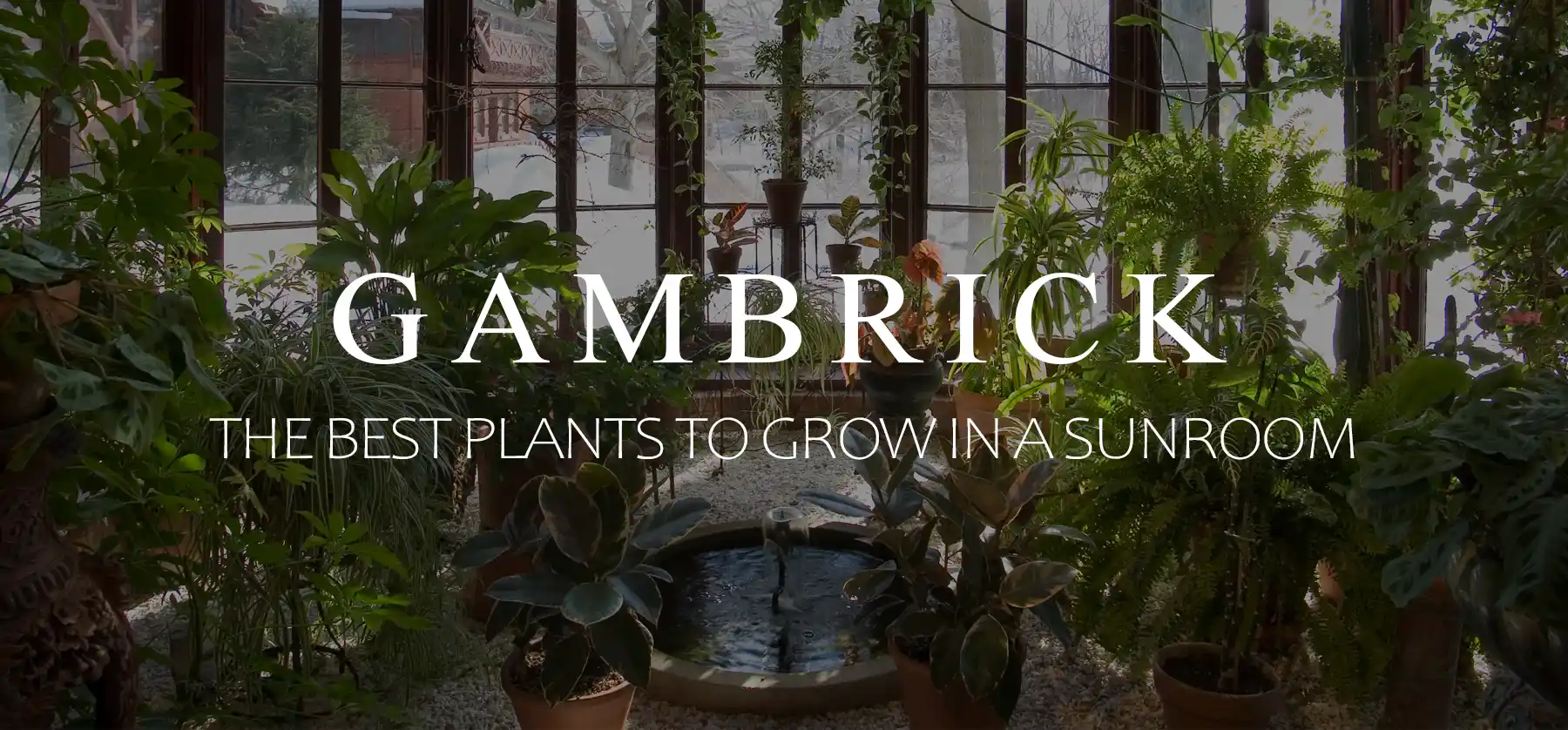
The Best Plants To Grow In A Sunroom

By John Mazzuca | About | More Posts |
John Mazzuca is a custom home builder with over 25 years experience in the construction industry. John has designed, managed, and built hundreds of homes & construction projects.
Sunrooms offer a unique environment that’s particularly conducive to growing a variety of plants. The reason some plants thrive so well in a sunroom is due to the ample sunlight and stable temperatures that mimic a plant’s natural habitat. In a sunroom, plants are protected from harsh weather, pests, and diseases that they might otherwise be exposed to outdoors.
I’ve been a sunroom contractor in NJ for over 25 years and can tell you firsthand that the best plants for sunrooms need lots of sun, don’t mind heat, and like a stable environment.
The bright, often consistent light in a sunroom provides the energy plants need for photosynthesis, which is the process they use to turn light into food. This is especially beneficial for flowering plants that require a lot of light to bloom. Moreover, the controlled environment of a sunroom means that temperature and humidity can be maintained at optimal levels for plant growth. For instance, tropical plants that love warmth and humidity can flourish in a sunroom where such conditions are easily met.
Sunrooms are an extremely versatile room that can offer the perfect balance of light for plants that need bright light but are sensitive to the harsh rays of direct sunlight. The glass panels of a sunroom can filter the light, providing a bright but diffused light that is ideal for the delicate leaves and flowers of many indoor plants. This can prevent issues like leaf burn, which can happen when plants are exposed to too much direct sunlight.
The Best Plants for Sunrooms
The best plants to grow in sunrooms need lots of light and warmer, consistent temperatures found in a sunroom.
Here are some of my favorites and why:
- African Violet: Thrives in bright, but not direct sunlight. Prefers room temperature conditions and humidity, without wet leaves. Water from the saucer to avoid pooling.
- Begonias: Needs bright, indirect light and acidic soil. Water should be poured into the soil to avoid leaf decay.
- Boston Ferns: Adaptable and can thrive in indirect light. Keep soil moist.
- Christmas Cactus: Prefers bright, indirect light and moderate moisture. Avoid over-watering.
- Croton: Requires bright, direct sunlight for colorful leaves. Needs well-draining soil and appreciates high humidity.
- Crown of Thorns: Blooms with direct sun and is tolerant of a wide temperature range. Requires well-draining soil.
- Fishtail Palms: Loves warm temperatures and humidity. Provide plenty of sunlight and moist, well-draining soil.
- Hibiscus Plants: Requires regular watering and about 6 hours of sun each day. Prefers a south-facing window in winter.
- Kalanchoe: A succulent that needs abundant bright light but not direct sun. Prefers well-drained, sandy soil and minimal watering.
- Meyer Lemons: Fruit-bearing and easy to grow indoors with 8-12 hours of sun. Prefers deep, infrequent watering.
- Orchid: Needs direct sunshine for a few hours a day. Requires moist, well-draining conditions and cooler night temperatures for blooming.
- Passion Flower: Ideal for warm sunrooms with plenty of bright light. Keep soil moist and provide full sun.
- Peace Lily: Prefers medium to low sunlight and well-drained soil. Tolerates underwatering better than overwatering.
- Spider Plant: Low maintenance, thrives in indirect light. Can recover from overwatering if allowed to dry out.
- String of Pearls: A succulent that prefers bright, indirect overhead light. Water sparingly.
- Umbrella Tree: Tolerates indirect and direct sunlight. Likes humidity but not sitting in water.
- ZZ Plant: Easy to grow, prefers bright, indirect light and can tolerate low light. Water every 2-3 weeks.
These plants are well-suited for sunrooms because they can handle the bright light and often warmer temperatures found in these spaces. Many of them also prefer the consistent temperatures that a sunroom can provide compared to the outdoors.
Can You Grow Vegetables in a Sunroom?
Some types of vegetables grow really well in a sunroom. Vegetables like tomatoes, peppers, and leafy greens often do well in the controlled environment of a sunroom.
A sunroom provides plenty of sunlight, which vegetables need to grow and produce fruit. The glass walls and roof of a sunroom let in the sun’s rays while protecting the plants from strong winds, heavy rain, and pests. This can lead to healthier plants and a longer growing season, especially in regions with cooler climates.
Tomatoes, for example, love the warm, sunny conditions that a sunroom can offer. They need at least 6-8 hours of sunlight a day to develop their sweet, full flavor. Peppers also thrive in similar conditions and can benefit from the stable temperatures a sunroom provides. Leafy greens like spinach and lettuce can grow well too, especially since the light can be controlled to avoid the hot midday sun, which can sometimes be too intense for these cool-season crops.
A sunroom can be an excellent place to grow a vegetable garden. With the right care, such as regular watering and feeding, vegetables can flourish in the abundant light and sheltered environment that a sunroom offers. It’s a great way to enjoy fresh produce right from the comfort of your home.
Tips for Choosing the Right Sunroom Plants
Choosing the right plants for a sunroom involves considering the aesthetics, the type of pots to use, and the maintenance required. Plants like African violets, ferns, and citrus trees are great options that grow well in sunrooms and don’t require much mainetenance.
When selecting plants for a sunroom, consider how they will look in the space. Aesthetics are important; you want plants that complement the room’s decor. African violets, with their vibrant flowers, can add a pop of color, while ferns can bring in lush greenery. For a sunroom, it’s also essential to choose pots that not only match your style but are functional. Pots with drainage holes are a must to prevent overwatering, and saucers can protect your floors from water damage.
Maintenance is another crucial factor. Some plants require more care than others. Citrus trees, for example, need plenty of sunlight and regular watering, but they can reward you with a fresh scent and even fruit. It’s also important to consider the plant’s needs for humidity and temperature, which can vary widely in a sunroom depending on the season and time of day.
When choosing plants for a sunroom, look for ones that will thrive in the bright light and that you can maintain easily. Consider how the plants will fit with the style of the room and choose pots that are both attractive and functional. With the right selection, your sunroom can become a beautiful and relaxing garden space.
Tips for Caring for Indoor Sunroom Plants
Caring for indoor sunroom plants requires attention to sunlight exposure, watering habits, and temperature control. These factors are key to ensuring your plants not only survive but thrive in a sunroom setting.
Sunlight is abundant in a sunroom, but too much direct light can harm some plants. It’s important to know each plant’s light requirements. For instance, ferns and orchids prefer indirect light and may need to be placed away from direct sun rays that can scorch their leaves. On the other hand, cacti and succulents love basking in full sunlight.
Watering is another critical aspect. Overwatering is a common mistake, so it’s essential to check the soil moisture before watering. Many sunroom plants prefer their soil to be slightly dry between waterings. For example, citrus trees and spider plants need well-draining soil and should not sit in water.
Temperature control can be challenging in a sunroom, as it can get quite hot during the day and cooler at night. Most indoor plants prefer a consistent temperature, so it may be necessary to use blinds or shades to manage the heat during the day and possibly heaters during colder nights.
Proper care for sunroom plants involves managing their exposure to sunlight, being cautious with watering, and keeping the temperature as consistent as possible. By doing so, you can create a thriving indoor garden in your sunroom.
Can Plants Stay In a Sunroom in Winter?
Yes, plants can stay in a sunroom during winter, but they may require extra care to cope with the colder temperatures and reduced levels of sunlight.
During winter, the amount of natural light in a sunroom can decrease significantly, and temperatures can drop, which might not be ideal for some plants. It’s important to ensure that the plants still receive enough light, which may mean supplementing with grow lights. Additionally, keeping the sunroom at a consistent temperature that suits the specific needs of your plants is crucial. For example, tropical plants will need a warmer environment, while cacti and succulents can tolerate cooler conditions.
Moreover, winter air can be dry, and many plants need a certain level of humidity to thrive. Using a humidifier or placing water trays near heating sources can help increase humidity levels. It’s also essential to adjust your watering routine, as plants tend to use less water in the winter months. Overwatering can lead to root rot and other issues, so it’s best to water only when the soil is dry to the touch.
Can House Plants Survive in an Unheated Sunroom?
House plants can survive in an unheated sunroom, but it depends on the type of plants and how cold the sunroom gets during the winter.
Most house plants come from tropical climates and are used to warm temperatures, so an unheated sunroom can be a challenge during cold winters. Some hardy plants, however, such as succulents and cacti, can tolerate cooler temperatures as long as they are not exposed to frost. It’s important to know the minimum temperature that each plant can handle and monitor the sunroom’s temperature closely during cold snaps.
To help plants survive, you can take steps to insulate the sunroom, like using thermal curtains or blinds at night to keep the heat in. Also, be mindful of watering; plants need less water in cooler temperatures, and overwatering can lead to issues like root rot. Grouping plants together can also help, as they can create a microclimate that retains humidity and warmth.
The Best Way to Arrange Plants in a Sunroom
Arranging plants in a sunroom can enhance the room’s beauty and the health of the plants. It’s important to consider the light needs of each plant, the room’s aesthetics, and the plants’ sizes and shapes.
When you start arranging plants in a sunroom, think about which areas get the most light. Place sun-loving plants like succulents and cacti in spots where they’ll get plenty of rays. Plants that prefer indirect light, such as ferns and orchids, can be set in areas that receive filtered light. It’s also a good idea to rotate your plants occasionally to ensure they get light evenly on all sides.
For a visually pleasing sunroom, mix and match plants of different heights and textures. Tall plants can go in the corners or behind furniture, while shorter plants can sit on tables or shelves. Hanging plants can add a vertical dimension to the space. Remember to leave enough space between plants for air to circulate; this can help prevent the spread of pests and diseases.
Arranging plants in a sunroom requires attention to the light requirements of each plant, the overall design of the room, and the health needs of the plants. With thoughtful placement and consideration for each plant’s needs, your sunroom can become a lush, inviting space filled with thriving greenery.
Tips on How To Display Plants in a Sunroom
Displaying plants in a sunroom effectively can create a vibrant and inviting space. The key is to consider the plants’ needs and how they complement the room’s design.
Firstly, assess the light conditions throughout the day and place plants accordingly. Sun-loving plants should be positioned where they’ll receive ample light, while those that require less can be set back from the windows or in shaded corners. This not only ensures their health but also helps to create a tiered effect in the display, with taller plants in brighter spots and shorter ones in dimmer areas.
Next, think about the containers. Using pots and planters that match or complement your sunroom’s decor can tie the room together. Consider the color, material, and design of the pots. Grouping plants in similar containers can create a cohesive look, while varying the pot styles can add interest.
Don’t forget to utilize different levels to add depth to the space. Use plant stands, shelves, or hanging planters to display plants at various heights. This not only makes the room more visually appealing but also allows you to fit more plants into the space.
Displaying plants in a sunroom involves careful consideration of their light needs and the overall aesthetic of the room. By choosing the right location and containers for your plants and playing with different heights, you can create a beautiful and healthy environment for both your plants and your home.
If you have any questions or comments email or leave a comment down below.

John Mazzuca | About | More Posts |
Custom Home Builder
John Mazzuca is a custom home designer and builder at Gambrick with over 25 years experience in the construction industry. John has designed, built and/or remodeled hundreds of homes, small buildings, and commercial projects. He writes about business, real estate, home building, and household electronics. His work has been featured in Fox Business, Better Homes & Garden, House Beautiful, and more.




















